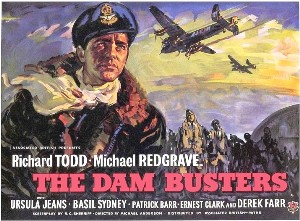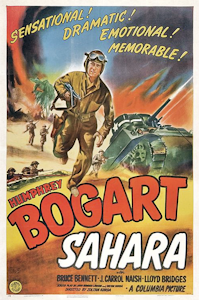BACK-STORY: “A Walk in the Sun” is a faithful rendering of the novel by Harry Brown. It was released in 1946 and is in black and white. It is set in 1943 during the invasion of Salerno in the Italian campaign in WWII. Production began after actor Burgess Meredith (who served as the narrator in the film) urged that the book be made into a movie. The director was Lewis Milestone of “All Quiet” fame. The U.S. Army cooperated in production by providing weapons, including American weapons masquerading as Germans. The Army also vetted the script suggesting two minor changes. The movie was greeted positively by audiences and critics. It was rereleased in 1951 as “Salerno Beachhead”.
OPENING SCENE: In an unorthodox use of credits, we are introduced to the main characters by face and name. The narrator tells us a little about each in a folksy way. They are members of the Texas Division. They are from all over the United States, however. The platoon includes an Italian-American, a factory worker, a minister's son, a farmer, a Southerner, and, of course, a guy from Brooklyn. Then to make things more intriguing, the ballad begins and will reappear periodically throughout the film. The men are on a landing craft heading for Salerno. We get our first taste of what’s to come as the men engage in typical soldier conversations. The big incident is the mortal wounding of their lieutenant as he incautiously looks over the side of the craft. The men take this setback in stride indicating both the enlisted/officer divide and the hardened attitude of combat veterans.
SUMMARY: The platoon lands on a quiet stretch of beach and digs in. The audience craving for action and violence is introduced to the reality of battles – there are large stretches of boredom and individual soldiers (and even small units) are usually clueless about what is going on elsewhere on the battlefield. Anyone expecting the talking to end at this stage of the movie is quickly disabused of that hope. However, the conversations are fascinating and feel like they come out of the mouths of G.I.s, not a Hollywood screenwriter trying to imagine what soldiers would talk about. We get a lot of 1940s slang so for those of you are not old enough here is a glossary of just a few of the terms:
loving = stands in for the "f word" (this is a 1946 war movie, remember)
take a powder = relax
hit the dirt = get down (used mostly when strafing is possible)
sure as little apples = very sure
hoist tail = get up
shake it = move quickly
take ten = take a break
doughfoot = soldier (variation of doughboy)
in the pink = healthy
And the term that was used at least ten times – “butt”. This refers to a cigarette as in “butt me” if you want one. This being a 1940s war movie, be careful of second hand smoke because these actors smoke every chance they get. The unit even has a pet phrase – “nobody dies”. This serves as a hoped for self-fulfilling prophecy. Audience, do not fear – it is not an accurate prediction of the upcoming events. By the way, the phrase eerily foreshadows “Hamburger Hill” and its “It don’t mean nothing”.
The plot is simple. The unit is sent on a mission to destroy a bridge and take a farm house. They are not told why. The rest of the movie is a series of action scenes interspersed with bouts of conversations. The soldiers talk about home, their futures (one keeps predicting that they will be in the Army all the way through the “Battle of Tibet”), food (one dreams of eating an apple), etc. Thankfully, no one pulls out a picture of his future wife, thus avoiding certain death. The men have developed an admirable small unit comradeship which allows them to constantly joke and provoke. My favorite exchange is when one of the privates asks Sgt. Tyne (Dana Andrews) if he can smoke. Tyne’s one word response is “Burn”.
They meet two Italian (“Eyties”) deserters. They are portrayed in typical Hollywood fashion as amiable dupes of Mussolini. This being a small unit war movie, there is of course an Italian-American in the heterogeneous platoon who can interrogate them. In a nod to “the fog of war”, they don’t know much about what the platoon will be facing up ahead. Soon after, the unit is strafed by a T-6 Texan playing a ME-190. They jump into a ditch in a scene reminiscent of the French jumping into the German trench in “All Quiet”. (I wonder if Milestone sued himself).
More marching, talking, and smoking. The comedy team of Friedman (George Tyne) and Rivera (Richard Conte) have the following typical exchange. Friedman: “When I run out of butts, you’ll be in a fine mess.” Rivera: “I’ll find a new friend”. Their leader Sgt. Porter is a victim of what they called “combat fatigue” back then - post-traumatic stress disorder to us. The men take it in stride and are understanding if not very sympathetic. Windy Craven (John Ireland as the soldier who composes letters home in his head) says “you don’t have to be bleeding to be wounded…. He has built a foxhole in [his mind].” Sgt. Tyne takes over because a guy’s gotta do what a guy’s gotta do.
In a cool scene, they ambush a German armored car by throwing what seems like fifty grenades and hammering it with the M-60 until it crashes into a tree. One of the men sprays Thompson bullets through an opening resulting in a dead hand protruding. You are left to imagine the inside of the vehicle. Rivera, the heavy machine gunner, is exhilarated which is an accurate depiction of combat adrenaline.
They reach the farm house which looks serenely threatening. Tyne sends a patrol which promptly reveals the house is occupied by Germans, to the mortal detriment of two of the men. The scene does accurately reveal the American army’s tactic of sending humans to discover an enemy position by exposing themselves to enemy fire. It also reflects the randomness of combat deaths. It is pure luck who survives.
Tyne develops a plan suggested by Windy. Being a good commander, he is open to suggestions. When the plan is outlined one of the men comments: “There are 3 ways to do things: the right way, the wrong way, and the Army way.”
FINAL SCENE: Sgt. Ward (Lloyd Bridges) leads a squad that wades upstream to blow the bridge with grenades. At a synchronized time, Rivera’s M-60 machine gun rakes the farm house as the rest of the platoon launches a frontal assault. The movie realistically tallies up the death toll, but the deaths are old school (bloodless, arms flying upward when hit = cliché #29). When the last bullet is fired, mission accomplished. Craven adds the post script: “Dear Francis, we just blew a bridge and took a farm house. It was so easy, so terribly easy.” The ballad swells.
RATINGS:
Action – 5
Acting – 8
Accuracy – N/A
Realism – 7
Plot – 8
Overall – 8
WOULD CHICKS DIG IT? I doubt it. There is not even a whiff of a woman in it. I would think most women, especially modern women, would find the conversations either perplexing or boring. However, if your significant other likes talking, there is certainly enough to satisfy anyone. Be prepared for the “why don’t you communicate with me like they do?” line. This movie has a lot of bromance before the term was coined.
CRITIQUE: I have to admit I have a soft spot for this movie. Since teachers can not show R-rated movies even in a Military History class, this movie is in my rotation. It fits one of the themes of my class: how soldiers behave. “Walk” does an outstanding job giving my students an idea of how soldiers talk and interact. Few war movies are truer to the sense of humor of American G.I.s. It also accurately portrays the “hurry up and wait” nature of combat. Most war movies spend way too much time on the fighting and way too little on the waiting.
The second theme I use the movie for is small unit tactical decision-making. Before we watch the last scene, the students imagine what their plan would be. Although the movie depicts the West Point solution to the problem, you can debate if a frontal attack is the best approach.
The acting is good throughout the ensemble. No one hams it up. Even Huntz Hall (of Bowery Boys fame) is impressive. He gets to argue that a human is more complex than a leaf. (That sounds silly, but is actually deep.) Dana Andrews as Tyne is the reluctant, but dutiful leader. He is not heroic and makes mistakes. In one shockingly bad decision, he allows the medic to scout ahead and he promptly gets killed. He wears the mantle of command uncomfortably, but ably.
There is not a lot of action and the violence is far from graphic, so modern audiences may find it boring. My students do not really appreciate it. It is also the most talkative war movie I can think of. With that said, the talking is often humorous and revealing of what soldiers actually think about. The thoughts are true to nature, but this being a 1940s movie some censoring has occurred. Vietnam War soldiers did not coin the “loving” f-word, after all.
ACCURACY: The movie is not based on any actual incident. The invasion of Salerno did start out as a “walk in the sun” as depicted in the movie. I have already commented on the accuracy of the soldier talk and behavior. The tactics also ring true. The seeming lack of emotions in dealing with fallen comrades is probably exaggerated to match the mood of the film, but battle-hardened men could conceivably be callous at this point.
CONCLUSION: “A Walk in the Sun” is unique in some respects. I know of no other war movie that has narration plus a ballad throughout the film. By the way, this approach predates “High Noon”. Granted, the song is very corny, but it is different.
The dialogue is memorable. Several lines are brilliant. Tyne: “It’s a funny thing how many people you meet in the army that cross your path for a few seconds and you never see ‘em again.”
"A Walk in the Sun" does not have the reputation of many other circa WWII movies, but it is one of the best. It is not amped up with action like most other movies from that time. It is also not as in your face patriotic, but it is also not pacifistic. It has more natural humor than a vast majority of the John Wayne type features. In some ways it is unique which makes it more interesting.
.jpg)




.jpg)
